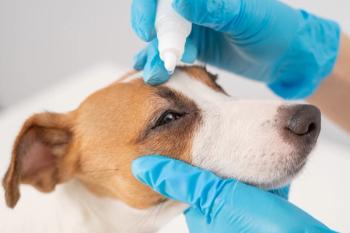
- dvm360 November 2021
- Volume 52
Managing feline stress-related conditions

Management of stress-associated conditions in cats should utilize a multi-pronged approach including ensuring basic needs are met, environmental enrichment, behavior modification, and the considered use of pharmaceuticals or supplements.
Veterinarians are increasingly aware of the role that stress can play in medical and behavioral conditions in our feline patients. But recognizing signs of stress is only the first step in improving the quality of life for cats experiencing stressors that impact their daily lives. During a session at the Fetch dvm360® Kansas City conference, Christopher Pachel, DVM, DACVB, CABC of the Animal Behavior Clinic in Portland will discuss practical tips for managing these stress-associated conditions in cats.
Recognizing stress
Cats are notorious for hiding illness, and behavioral changes related to chronic stress may be subtle. At times, pet owners may present the cat to the veterinarian for changes in activity, appetite, or social interaction. In other cases, the cat may be presented for hair loss, inappropriate elimination, upper respiratory infections, or other physical illness. In these cases, it falls on the veterinary team to identify the presence of stress-related behaviors and potential stressors through careful history taking and educating their clients on the role that stress plays in these medical presentations.
Principles of behavioral treatment plans
Pachel encourages practitioners to consider a three-pronged approach to management of stress-associated conditions in cats, including “behavioral modification, environmental management, and ‘medication,’ which may include nutritional support, supplements, pheromones, and pharmaceuticals.” He notes that each patient will have a customized treatment plan and not every prong will be used in all cases.
The
Environmental management
Assessing the cat’s home environment is an important first step in management of environmental factors that may contribute to stress. A sample history questionnaire that can help with environmental assessment is available
Pachel notes that for cats, it is not just about whether a resource (food, water, litter box, and safe hiding locations) is available, but also whether the cat perceives that it is available. He suggests an in-person walk-through or use of telemedicine platforms and owner-recorded video of the home as tools that can be used to assess the home environment. After the assessment, changes to the environment can be discussed that improve resource availability to reduce daily stress.
Addition of enrichment opportunities to a cat’s environment can help to reduce stress. Pachel notes that it may take some trial and observation to find the right type of enrichment for each individual patient, but the results can be highly rewarding. Consider opportunities for the cat to expend energy, engage in species-typical behaviors such as climbing and hunting, and providing mental stimulation. Enrichment can be incorporated into feeding time (i.e. use of a food puzzle), training, and more.
Behavior modification
While many believe that cats cannot be trained, Pachel states that “behavior modification strategies are absolutely available for cats,” and they “can have a dramatic impact on stress-associated conditions.” There are many specific skills that can be taught to cats using traditional learning techniques, such as habituation, classical conditioning and operant conditioning. Pachel notes that there are species-specific training considerations, including the amount and type of reward and feline body language indicating readiness to progress to more difficult training.
Medication
“Medication” can be delivered to cats in many ways, and may include nutritional support, supplements, pheromones, and pharmacological interventions. For any of these medical interventions, a trial-and-observation approach is often needed. Pet owners should be made aware that the first product selected may not work, but that does not mean any future medications or supplements will be failures as well.
Nutritional support is found in the form of prescription diets with added ingredients to reduce stress levels while support the health of specific systems, including urinary and gastrointestinal. If these diets are found to be helpful, a large advantage over other medication options is the improved compliance seen with administering a diet compared to administration of a pill or supplement.
Supplements and pheromones are available in a wide variety of cat-specific products. Pachel encourages practitioners to get familiar with not only the individual products but their active ingredients, which may aid them in choosing the best product to try for a particular patient. Pheromone products mimic natural feline pheromones and are often delivered to the environment instead of the patient directly, which may make them easier to incorporate into an intervention strategy.
Pharmacological intervention is appropriate for some pets with stress-associated conditions that are motivated by fear, anxiety, stress, and arousal. Pachel states that for behaviors with other motivations, medication is unlikely to help and may, in fact, be contraindicated. If medical therapy is deemed appropriate, veterinarians must consider whether a situational or daily maintenance medication is indicated and the type of medication, including the target neurotransmitter and potential side effects, that will best address the patient’s condition.
For any of the medication options, Pachel suggests careful assessment of owner compliance and ability to administer medication when selecting the best product(s) to try. If medication or supplement administration is stressful for pet and owner, long-term use is unlikely, and the added stress of medication administration may negatively impact the patient or harm the bond between pet and owner. Use of compounded medications, feline-friendly medication administration, and positive reinforcement with a high-value reward can all be discussed as options to reduce stress and improve compliance.
Take home points
A partnership between pet owner and veterinary team is needed to maximize outcomes for stress-related behavioral and medical conditions in feline patients. Once stress-related conditions are recognized, intervention strategies should be designed that include environmental management, behavioral modification, and/or medication. Each cat will require an individualized treatment plan that addresses their specific needs and is feasible for the pet owner to implement. Join Dr. Pachel on [date] at [time] at the Fetch dvm360® Kansas City Conference to learn more about management of stress-associated conditions in feline patients.
Dr Boatright, a 2013 graduate of the University of Pennsylvania, is a practicing veterinarian and freelance speaker and author in western Pennsylvania. She is passionate about mentorship, education, and addressing common sources of stress for veterinary teams and recent graduates. Outside of clinical practice, Dr. Boatright is actively involved in organized veterinary medicine at the local, state, and national levels.
Articles in this issue
about 4 years ago
National Pet Diabetes Month: Raising awareness and making stridesabout 4 years ago
A breakthrough joint supplement for dogs and catsabout 4 years ago
Dental Pain and Inflammation—Acute and Chronicabout 4 years ago
Veterinary technicians embrace their rolesabout 4 years ago
Understanding and diagnosing canine hypothyroidismabout 4 years ago
Embark Veterinary releases first-ever purebred dog DNA kitabout 4 years ago
Zoetis adds digital cytology testing to Vetscan ImagystNewsletter
From exam room tips to practice management insights, get trusted veterinary news delivered straight to your inbox—subscribe to dvm360.




